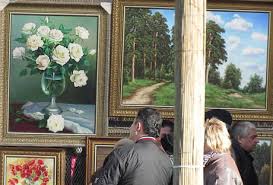development
STYLES AND DIRECTIONS IN THE FINE ART (part 1)
 The number of styles and directions is huge, if not endless. The key feature by which works can be grouped by style is the unified principles of artistic thinking. The change of some methods of artistic thinking by others (alternation of types of compositions, methods of spatial constructions, peculiarities of color) is not accidental. Historically changeable is our perception of art.
The number of styles and directions is huge, if not endless. The key feature by which works can be grouped by style is the unified principles of artistic thinking. The change of some methods of artistic thinking by others (alternation of types of compositions, methods of spatial constructions, peculiarities of color) is not accidental. Historically changeable is our perception of art.
Building a system of styles in a hierarchical order, we will adhere to the Eurocentric tradition. The largest in the history of art is the concept of the era. Each era is characterized by a certain “picture of the world”, which consists of philosophical, religious, political ideas, scientific ideas, psychological characteristics of worldview, ethical and moral norms, aesthetic criteria of life, which distinguish one era from another. Continue reading
HISTORY OF LANDSCAPE GENRE DEVELOPMENT (part 2)
 Landscape motifs began to play a more important role during the High Renaissance. Many artists began to carefully study nature. Having abandoned the usual construction of spatial plans in the form of wings, piling up parts that are inconsistent in scale, they turned to scientific developments in the field of linear perspective. Now the landscape, presented as a whole picture, is becoming an essential element of artistic plots. So, in the altar compositions, which the painters most often referred to, the landscape looks like a scene with human figures in the foreground. Continue reading
Landscape motifs began to play a more important role during the High Renaissance. Many artists began to carefully study nature. Having abandoned the usual construction of spatial plans in the form of wings, piling up parts that are inconsistent in scale, they turned to scientific developments in the field of linear perspective. Now the landscape, presented as a whole picture, is becoming an essential element of artistic plots. So, in the altar compositions, which the painters most often referred to, the landscape looks like a scene with human figures in the foreground. Continue reading
HISTORY OF LANDSCAPE GENRE DEVELOPMENT (part 1)
 Translated from French, the word “landscape” (paysage) means “nature”. This is what the genre is called in fine art, the main task of which is the reproduction of natural or human-modified nature.
Translated from French, the word “landscape” (paysage) means “nature”. This is what the genre is called in fine art, the main task of which is the reproduction of natural or human-modified nature.
In addition, the landscape is a specific work of art in painting or graphics, showing the viewer nature. The “hero” of such a work is a natural motif or a natural motif invented by the author.
Elements of the landscape can be found already in cave art. In the Neolithic era, primitive masters schematically depicted rivers or lakes, trees and stone blocks on the walls of caves. On the Tassilin-Ager plateau in the Sahara, drawings were found with scenes of hunting and driving herds. Continue reading




